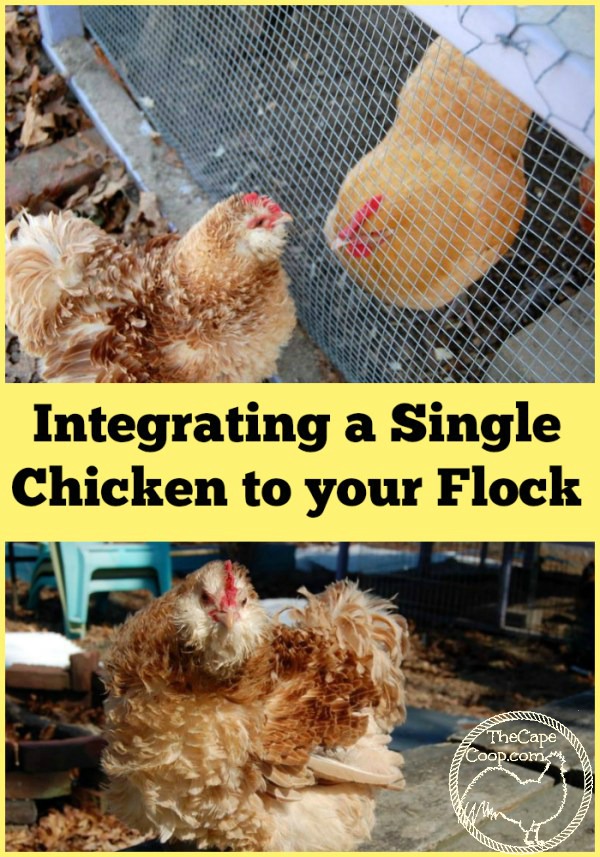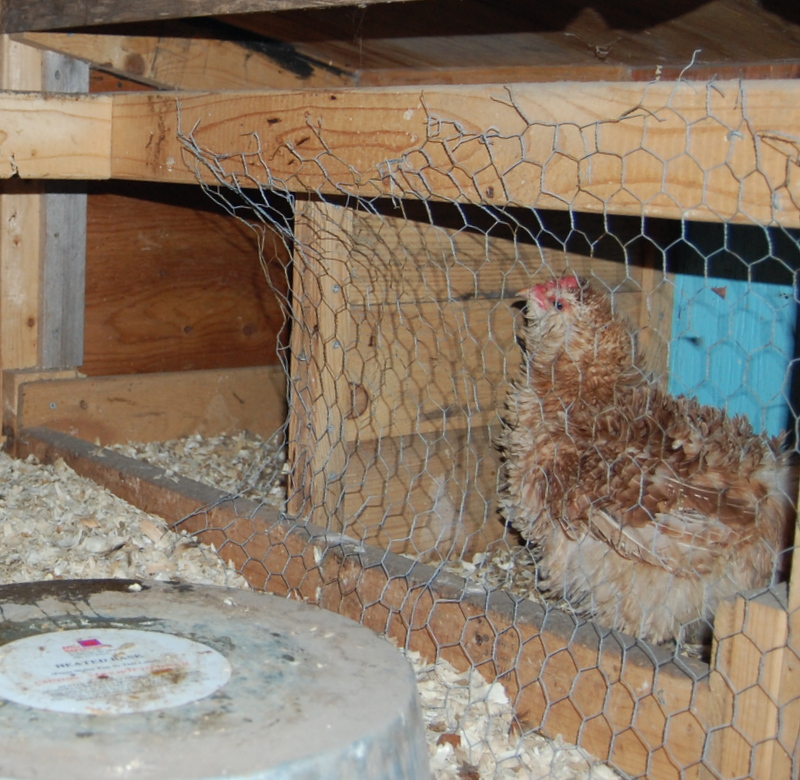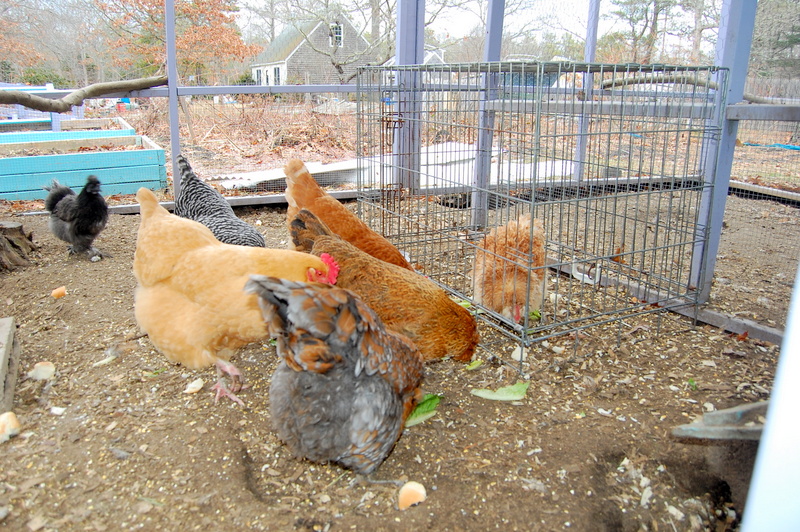---------------------------------------------------------
As your flock grows and changes, there will be times when you want to integrate a new chicken into your existing flock. You might find a gorgeous hen at the feed store, or an ad online for the rare breed you have been looking for. This can be a stressful time for both you and your chickens. It can be hard to watch your old, friendly flock turn vicious while picking on a newcomer, and it’s hard to watch your new chicken friend get bullied.
There are a few things you can do to make the transition as smooth as possible, but there WILL be fighting as a new pecking order is established. Sometimes fighting can even break out among the old flock mates as some take advantage of the commotion to move up the pecking order ladder.
If possible, try to avoid adding just one new chicken. If you get two chickens, they at least have each other. It also helps to spread out the bullying behavior so it’s not the entire flock picking on one new chicken. It is possible though, with patience and care to add a single new chicken. I would strongly recommend against introducing a single chick to an adult flock. The adults could easily kill the younger bird. Click here for tips on introducing chicks to your older flock.
Quarantine
First, you should always quarantine any new chickens for about a month before you begin the integration process. Failure to quarantine new chickens can result in illness or parasites being introduced into your healthy flock. You don’t want to risk the health or life of your existing flock.
Quarantined birds should be kept at least 30-40 feet away from your old flock, and you should be careful not to carry pathogens yourself by sharing equipment between the flocks. During the quarantine period carefully monitor the new chickens for signs of illness such as coughing, sneezing, discharge from eyes or nostrils, lameness, discolored wattles or combs, unusual droppings, or lack of appetite.
Step 1 Introductions
When you are ready to begin the integration process, you don’t want to just throw the new chicken in the run and let them sort it out. Use a wire dog crate to allow the chickens to get used to each other without the risk of injury. If you don’t have a large enough crate, try separating a section of your run. Click here to see how I built a mini coop for $2! On the first day, I like to have the dog crate just outside the run. The old flock can see the new chicken and smell the new chicken. But she isn’t in their space yet so the old flock doesn’t think it’s too big a deal.
IMPORTANT – Don’t forget the food and water in the crate. Also don’t leave the new chicken(s) outside at night in the dog crate. It doesn’t provide adequate predator protection, and the chicken will be very stressed out left in the open after dark. At night, either move the new chicken back to the secured quarantine area or section off part of the coop where they can sleep. We like to block off a nest box with wire for the new chicken to sleep in.
Step 2 Introductions
On the second day, move the crate into the run. Give everyone lots of treats! Have some of your flock’s favorites on hand and pass out the treats often, helping them interact and get used to each other.
For the next few days, continue keeping the new chicken in the crate in the run during the day, and secured at night.
Step 3 Introductions
After a few days, try letting the flock all out together to free range. Free-ranging in the yard gives the newbies space to run away if needed and is a more neutral ground than the coop & run. Keep a close eye on the birds during this time. Some chasing is to be expected. You might also see the older girls taking a few swipes at the new chicken. Short free ranging sessions are best. The new chicken has plenty of space to escape and isn’t hanging around long enough to really get on anyone’s nerves.
Step 4 Introductions
After about a week it’s time to mix your new chicken in with the flock permanently! The best way to do this is to wait until dark when everyone is calm, quiet, and roosting. Take the new chicken and put her on the roosts with the old chickens.
Set your alarm for sunrise the next morning – you don’t want to sleep in and leave the new chicken with nowhere to escape locked in the coop! Let the chickens out in the run together as early as possible that day. Check on them several times per day for the next week or so. Make sure everyone finds their way into the coop at night, some chickens may need you to pick them up and put them to “bed” for a few days while they get the hang of flock life.
Some bullying is to be expected but keep an eye out for injuries. A quick peck or swipe is normal, as is chasing the new bird away. If any of the chickens are injured or bleeding, remove them from the flock right away until they are healthy again. If there is one chicken in particular (usually the top hen) who is relentlessly picking on others, take that chicken and put HER in the wire crate in the run. Sometimes a “time out” is needed until she can be nice to her friends! Make sure the new chicken is getting adequate water & food, and that the older flock members aren’t keeping them away from it.
Before you know it, the flock will be one and everyone will be happily scratching about the run again!










chicken
Monday 25th of March 2024
Why does my chickens like to cross the road and go to my neighboor
Liz
Tuesday 26th of March 2024
lol sounds like an age old problem. My guess is you neighbor has more insects in their grass or tastier plants to eat. But sometimes chickens just get bored and like to forage, they don't care about property lines. It's best to put up a fence so they don't get hit by a car or eat something they shouldn't (or annoy your neighbors by leaving chicken poop around their yard). A 4 foot tall fence will contain the majority of chickens
Tammy
Tuesday 19th of July 2022
Hi, I’m kinda new to raising chickens. About a year ago I started with 3 chick’s, I lost one due to an infection in her leg. About 2 months ago my hen went broody so I went and got her a single chick to raise. I read I should always start with 2 chicks but when I went to the chicken shop near my house the worker told me it was no problem to add just one. I thought this was strange but they’re the chicken experts so I trusted them. I snuck my single chick under my broody hen at night and in the morning mommy hen was so happy to have a chick. All was great until she was 5 weeks old, then mom just abandoned her and started pecking at her with my other hen. It was heartbreaking to see! I spent weeks outside with them and making sure the chick was eating and not hurt. It has gotten a lot better but they still continue to chase and peck her especially around food. They have never hurt her but my poor chick is terrified to be next to them but still follows them around. It breaks my heart to see the other 2 always next to each other while baby sits close and watches. Will they ever accept her? She’s about 2 months right now. What should I do? I can’t find another 2 month old. Also, I’m afraid to bring another chick home, it might cause more problems? Any advice would be greatly appreciated!
Liz
Wednesday 20th of July 2022
It can be really tricky to get a single chicken integrated. They will accept her eventually. Unfortunately how long that takes is really up to the personalities of your hens. You are doing everything correct though - continue to keep a close eye on her. It's a good sign that they aren't trying to hurt her just chasing her off. Keep making sure she is getting enough food & water, hopefully it won't be much longer
Ella
Thursday 9th of September 2021
Im very late to the game, but, I have 4 Buff Orpintons and I got a Silkie from my friend. I quarantined her, but to where they could see each other. all went well and now they have been just hanging out eating treats,some pecking order has been made so 2 weeks later i put the Silkie into the coop with the rest. Today is Thursday. I am leaving on saturday morning ill be home sunday, Do you think it would be okay to leave them together? Or should i put her back into her safe space and let them visual see again untill im back?
Liz
Friday 10th of September 2021
I am sorry I am just seeing this now - Friday night - if they have been getting along alright with no real fighting I would let them stay together. If you have noticed any bully behavior I would separate her, just in case, until you return
stella
Sunday 11th of July 2021
Hi! Thank you for this!!! So we have 3 chickens- one buff orpington, and easter egger and a cream legbar and we just introduced a 14/15 week small gamefowl bird. the easter egger who is at the current bottom of the pecking order, pinned her down and then the buff (who is the top of the pecking order) joined in. we don't want any serious injuries so we broke it up and put the easter egger in a pin in the run. Now we have the gamefowl with the buff and the legbar hoping there can be some peace and then we will re introduce the easter egger. The gamefowl is just staying high up on perches, etc, to stay out of everyones way. When do I let the easter egger back out again and do you feel she'll be just as aggressive when we do? She was pretty vicious. And if I spray the mean chickens with a squirt bottle when they are mean, does that mess up them working it out- like I'm intervening too much?
Liz
Tuesday 13th of July 2021
I would let them live side by side by in the separate pen for at least a week, possibly two if you can. This will let her slowly adjust to the idea of a new friend. You can expect there to be a little fighting as they work things out and for the most part they will need to work it out on their own. If the new one is being kept from the food/water or if anyone is bleeding I would separate again, but hopefully it won't be long until they are one happy flock!
Sita
Thursday 10th of June 2021
My sweet Arjuna has integrated with the flock. Thank you for the recommendations and the support. She's so happy to be back with her flock.
Liz
Thursday 10th of June 2021
That is so wonderful to hear!